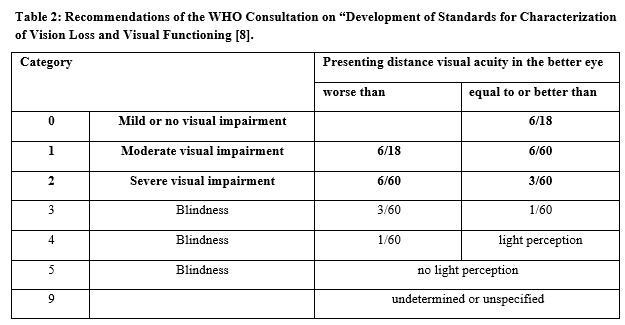Age-specific magnitude and causes of visual impairment in a tertiary health care centre in rural Karnataka
Abstract
Introduction: Approximately 80% of all vision impairment globally is considered avoidable. More than one-fifth of visual impairment is contributed by people in the age group of 0–49 years. Hence this study was conducted to determine the magnitude and causes of visual impairment among the population aged between 15-50 years and to determine the association of visual impairment with sociodemographic variables.
Methodology: This study was a Hospital-based cross-sectional study conducted between February 2019 to January 2020 at R L Jalappa Hospital and Research Centre, a tertiary care hospital at a rural area, Tamaka, Kolar. The sample size was 400 and consisted of all patients aged between 15-50 years, who visited Ophthalmology outpatient department. After noting subjects sociodemographic details according to the updated BG Prasad socioeconomic classification, all subjects underwent comprehensive ophthalmic examination.
Results: Refractive error was found to be present mostly in the age group of 31-45 and it was most commonly seen in the graduates. Uncorrected refractive error (55%) was found to be the most common cause of visual impairment, followed by cataract (30%). Other anterior segment pathology and posterior segment pathology accounts for 6.5% and 7.5% respectively of the visual impairment.
Downloads
References
Bourne RRA, Flaxman SR, Braithwaite T, Cicinelli MV, Das A, Jonas JB, et al. Magnitude, temporal trends, and projections of the global prevalence of blindness and distance and near vision impairment: A systematic review and meta‑analysis. Lancet Glob Health. 2017;5(9):e888‑97.doi: 10.1016/S2214-109X(17)30293-0.
Disabled Persons in India [Internet]. National Sample Survey Organisation, Ministry of Statistics and Programme Implementation Government of India; 2003. Available from: http://mospi.nic.in/sites/default/files/publication_reports/485_final.pdf.
Frick KD, Gower EW, Kempen JH, Wolff JL. Economic impact of visual impairment and blindness in the United States. Arch Ophthalmol. 2007;125(4):544‑550. doi: 10.1001/archopht.125.4.544.
WHO | Blindness: Vision 2020 – The global initiative for the elimination of avoidable blindness [Internet]. WHO. Available from: http://www.who.int/mediacentre/ factsheets/fs213/en/.
Universal Eye Health Global Action Plan 2014–2019 [Internet]. World Health Organization; 2013. Available from: http://www.who.int/blindness/AP2014_19_English.pdf?ua=1.
Loughman J, Nxele LL, Faria C, Thompson S, Ramson P, Chinanayi F, et al. Rapid assessment of refractive error, presbyopia, and visual impairment and associated quality of life in Nampula, Mozambique. J Vis Impair Blind. 2015;109(3)199‑212. doi: 10.1177/0145482X1510900304.
Pandey VK, Aggarwal P, Kakkar R. Modified BG Prasad’s Socio-economic Classification-2018: The need of an update in the present scenario. Indian J Comm Health. 2018;30(1):82-84. Available from: https://www.iapsmupuk.org/journal/index.php/IJCH/article/view/803.
International Statistical Classification of Diseases and Related Health Problems. 10th Revision (ICD-10)-WHO Version for 2016 Chapter VII-Diseases of the eye and adnexa (H00-H59). Available on http://apps.who.int/classifications/icd10/browse/2016/en#/H53-H54.
Ferraz FH, Corrente JE, Opromolla P, Schellini SA. Influence of uncorrected refractive error and unmet refractive error on visual impairment in a Brazilian population. BMC Ophthalmol. 2014;14(1):84. doi: 10.1186/1471-2415-14-84.
Jeganathan VS, Robin AL, Woodward MA. Refractive error in underserved adults: causes and potential solutions. Curr Op Ophthalmol. 2017;28(4):299. doi: 10.1097/ICU.0000000000000376.
Naidoo KS, Leasher J, Bourne RR, Flaxman SR, Jonas JB, Keeffee J, et al. Global vision impairment and blindness due to uncorrected refractive error, 1990 2010. Optom Vis Sci. 2016;93(3):227 234. doi: 10.1097/OPX.0000000000000796.
Chan V, Mebrahtu G, Ramson P, Wepo M, Naidoo K. Prevalence of refractive error and spectacle coverage in ZobaMa’ekel, Eritrea: A rapid assessment of refractive error. Ophthalmic Epidemiol 2013;20:131 137. doi: 10.3109/09286586.2013.783082.
Masayo ER, Chan VF, Ramson P, Chinanayi F, Naidoo KS. Prevalence of refractive error, presbyopia and spectacle coverage in Kahama district, Tanzania: A rapid assessment of refractive error. Clin Exp Optom. 2015;98:58 64. doi: 10.1111/cxo.12207.

Copyright (c) 2020 Author (s). Published by Siddharth Health Research and Social Welfare Society

This work is licensed under a Creative Commons Attribution 4.0 International License.


 OAI - Open Archives Initiative
OAI - Open Archives Initiative



















 Therapoid
Therapoid

